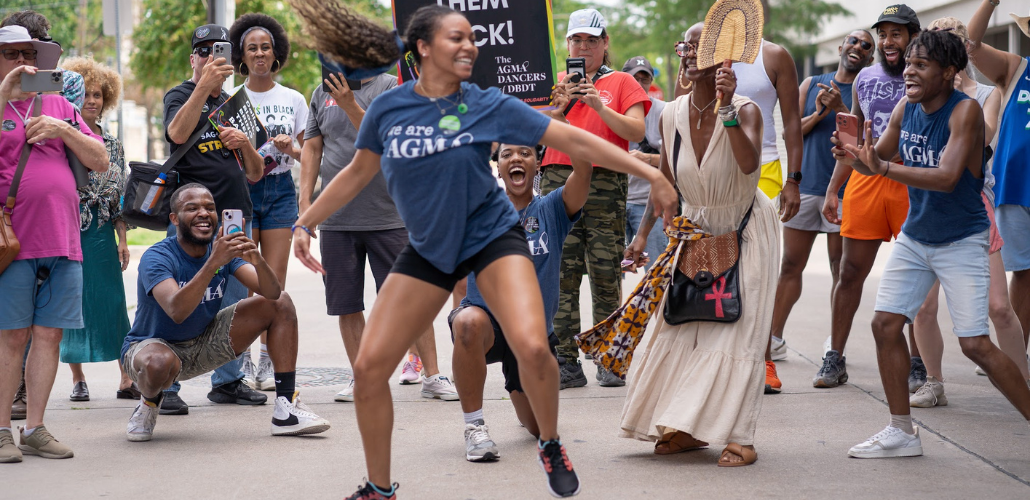Dallas Black Dancers Fight for Their Union

In a blatant violation of labor law, the Dallas Black Dance Theatre fired the entire company of dancers after they unionized. Member Gillian Clifford dances on the picket line; fellow dancers behind her in blue AGMA shirts are, from left to right, Terrell Rogers Jr., Nile Ruff, and Elijah W. Lancaster. Photo: Nathan Bullock
Leave it to performing arts unions to make a picket line that grabs attention. The rally outside Dallas Black Dance Theatre included a drummer, line dancing, and spontaneous performances from the unionized dancers.
The August 17 picket drew 200 people supporting the entire 10-member primary dance company, who were fired less than three months after they voted to unionize under the American Guild of Musical Artists.
Hours before the dancers’ termination, DBDT called auditions for August 17 for scab dancers. Immediately, AGMA issued a “do not work” order for the auditions, something that is reserved for the most egregious cases.
The company’s original 14 dancers filed for unionization at the end of April. An election was held on May 29, resulting in the unanimous vote.
WORKING MULTIPLE JOBS
Every dancer in the company worked multiple jobs to make ends meet, complicated by touring. “When we go on tour, about once a month, we’re unable to supplement, some of us losing $1,200 per week,” explained dancer Terrell Rogers Jr. Meanwhile, their per diem didn’t cover daily meals.
Administrators policed dancers’ appearance to a bizarre degree. “I got an infraction for wearing a bandana during a meeting about benefits,” said dancer Elijah W. Lancaster. Lancaster and dancer Nile Ruff described a culture where men weren’t allowed piercings and hairstyles were strictly regulated. Ruff said, “The dance space is supposed to be a creative space, and to have limits put on what we looked like was challenging.”
Dancers also suffered in a studio with unpredictable temperatures and insects. This point was underscored when management met with dancers before the election to urge them against unionizing. As the dancers checked off boxes on the union-busting bingo cards AGMA provided, a roach crawled across the ceiling of the room.
Dancers hope the union can force administrators to advocate for them as well. Rogers said host venues recently ignored hospitality riders in their contracts and DBDT wasn’t doing anything about it.

SUPPORT LABOR NOTES
BECOME A MONTHLY DONOR
Give $10 a month or more and get our "Fight the Boss, Build the Union" T-shirt.
After the unanimous vote, management refused to replace four departing dancers, leaving the remaining 10 with a heavier workload. Retaliation continued when the dancers were barred from teaching at the DBDT academy, a crucial additional income source.
Backlash after the mass termination led DBDT to turn off all social media comments. Then it claimed the termination was unrelated to the union vote, instead due to a video on the union’s Instagram page. In a Dallas Morning News op-ed, DBDT executive director Zenetta Drew claimed the video violated policies against vulgarity, violence, and profanity.
The video, on the @dancersofdbdt Instagram, is a compilation of silly moves while text introduces them by name. After Drew’s op-ed, dancers produced past footage showing that all the dance moves seen in the video were comparable to dancing seen in actual shows.
A WHOLE NEW WORLD
Dancers have found incredible support in local labor and arts communities. “In the beginning, we were just shocked and overwhelmed,” said Rogers, “But that turned to gratitude that people cared so much about us, about workers, about unions. There’s a whole world that we’ve been introduced to and a whole plethora of information. I didn’t know all the things I’m learning about the NLRB, I didn’t know just how strong unions are and what they actually do and how they really protect people.”
Now, the dancers seek justice, though simply getting their jobs back with no change in leadership may no longer be enough. Ruff said “As artists, we give our whole selves, and so for them to treat us in that way, people we’ve shared moments with, it’s hurtful. I would need a fundamental shift in leadership, to one that cares about the artist.”
In her op-ed, the executive director touted “37 years of experience in the arts and dance industry.” However, says Elijah Lancaster, “being in the industry for 37 years doesn’t mean you’ve danced, doesn’t mean you know what dancers experience and feel every single moment on stage and off.”
As Rogers puts it, DBDT leadership must “make room for more competent people who have the ability to empathize with artists.”
Rosemary Curts is a teacher and member of AFT Local 2260.


